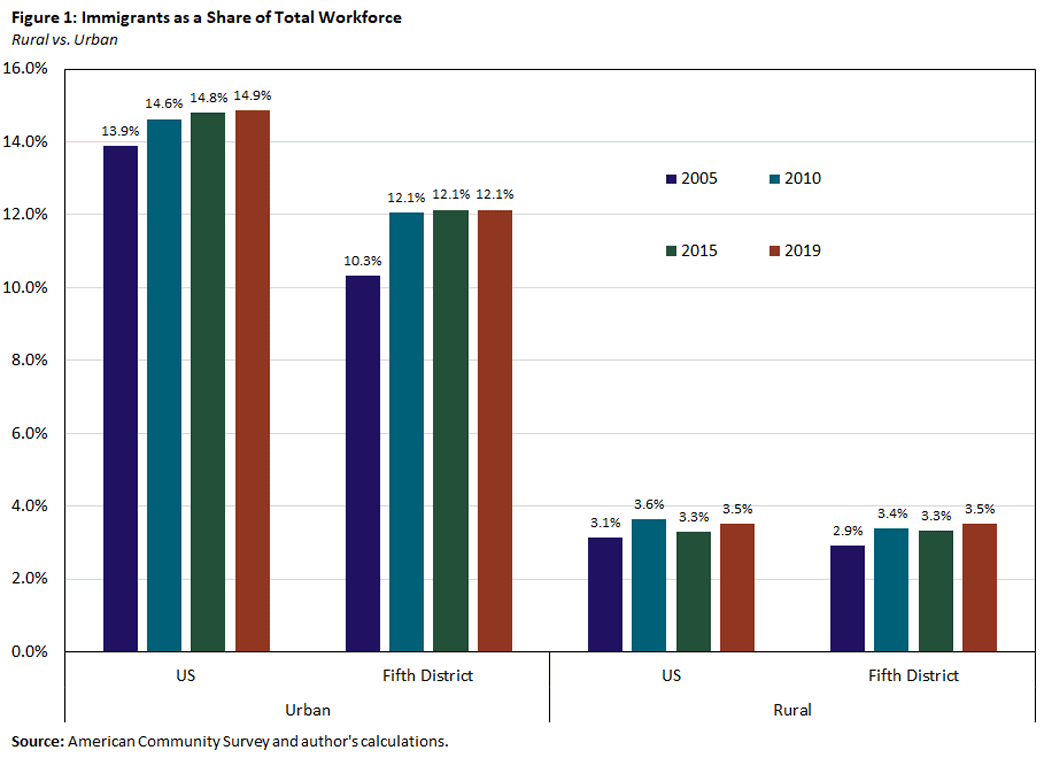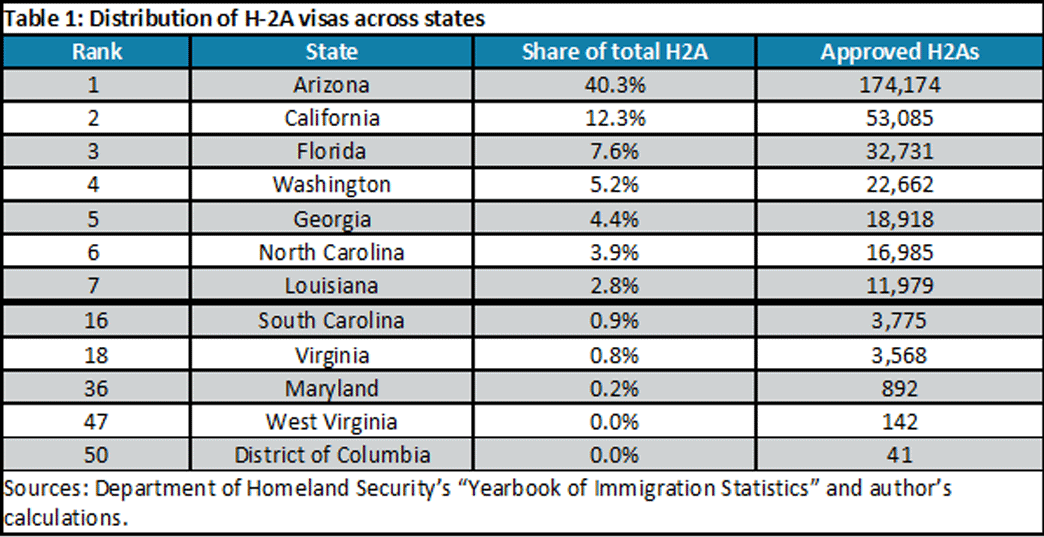Can Immigration Help Boost Rural Economies in the Fifth District and Beyond?
We examine the role of immigration in rural areas. While immigrants tend to concentrate in urban areas, rural areas also significantly benefit from immigration. Agricultural firms, for example, need to hire many immigrants to help with harvesting crops. Past restrictions to immigration in rural areas haven't proven to be very effective in boosting native worker employment in these areas. First, firms respond to such restrictions by investing in new technologies at the expense of labor. Also, native workers seem unwilling to take many jobs in rural areas, which makes immigrants particularly valuable to meet labor demand.
Immigration has been a central topic in academic and policy debates for decades. However, most of the discourse on immigration policy has been focused on understanding the labor market impact of immigration in urban areas, as most immigrants settle in cities.
Rural areas, however, can also benefit significantly from immigration:
- Immigrants can bring skills not available in the local labor market.
- They can help fulfill seasonal labor shortages in industries like agriculture and tourism.
- They spend money and pay taxes in their local communities, which can help develop other businesses.
Conversely, one argument against immigration into rural areas might be that immigrants compete with U.S. workers for an already scarce number of jobs.
In this article, we'll examine the benefits and risks of immigration in rural economies, with a special focus on the Fifth Federal Reserve District.1
Immigrant Shares of Total Workforce
We start by looking at the differences between urban and rural areas when it comes to the shares of their workforces that are immigrants.2 The share is smaller in rural areas, as shown in Figure 1.
While 14.9 percent of workers in urban areas in 2019 were immigrants, only 3.5 percent of workers in rural areas were born abroad. Urban areas in the Fifth District have smaller shares of immigrants than the U.S. average, with 12.1 percent of workers being immigrants in 2019. Rural areas in the Fifth District, however, closely follow the national average. Over time, the share of total workers who are immigrants has remained fairly constant, with urban areas showing a slight increase.
If we zoom into the distribution of rural immigrants across the Fifth District, we can see significant differences across states, as shown in Figure 2.
North Carolina accounts for 39 percent of the rural workers of the Fifth District but employs 51 percent of rural immigrants. On the other extreme is West Virginia, which accounts for 15 percent of the share of rural workers, but only 5 percent of rural immigrants.
When it comes to educational qualifications, rural areas attract more immigrants without college degrees. Only 4.1 percent of new immigrants with college degrees located in rural areas in 2019, compared with 6.8 percent of new immigrants without college degrees. However, immigrants can provide useful skills that are not easily available in rural areas. For example, 14 percent of physicians and surgeons in rural areas were immigrants in 2019, a significant fraction considering only 3.5 percent of the rural workforce are immigrants.
The Role of Immigrants in Agriculture
Despite rural areas being less intensive on immigrants, foreign workers do represent a significant share of the workforce in specific industries and occupations. Immigrants are commonly employed in construction and repair, or services such as personal appearance workers and cleaning staff, and they comprise especially large shares in the Food Manufacturing, Animal Production and Crop Production sectors, where they make up at least 12 percent of the workforces. Within Food Manufacturing, immigrants concentrate in firms that specialize in meat, poultry and fish processing such as beef packing firms. Within Animal Production and Crop Production, immigrants tend to concentrate in crop handling.
Regarding crop handling specifically, the 2020 report "H-2A Visas for Agriculture: The Complex Process for Farmers to Hire Agricultural Guest Workers" notes that almost 80 percent of crop handlers in the U.S. in 2016 were born outside of the country, and almost 50 percent did not have legal permission to work in the U.S. Immigrants are particularly valuable in agriculture due to the seasonal nature of the business, where harvest happens only a few times a year and high numbers of workers are required during very specific times.
H-2A Visas for Immigrants in Agriculture
While undocumented immigrants fill a large portion of such seasonal vacancies, there are legal pathways to hire temporary agricultural labor. More specifically, the H-2A visa is a temporary visa for agricultural workers to come to the U.S. and work for a specific employer for less than one year. These workers can then move to other employers in need of seasonal labor until they reach a cap of three years, at which point they need to exit the U.S. for a period.
To hire an H-2A worker, employers first need to advertise the job to native workers at competitive market wages. If native workers apply, they should be given preference until reaching at least 50 percent of the vacancies.
As pointed out by the aforementioned 2020 report, evidence suggests that when border enforcement is higher, applications for H-2A visas go up, meaning it could be a policy tool to reduce illegal immigration. However, applying for such visas is administratively complicated, and the restriction to seasonal work prevents dairy farms or other year-round agricultural jobs from benefitting.
H-2A visas account for almost 10 percent of agricultural employment in the U.S. As shown in Table 1, Arizona is where most of these workers are located, accounting for 40 percent of the visas in 2019. When looking at the Fifth District, North Carolina accounts for almost 4 percent of the nation's H-2A visas, while the rest of the Fifth District combined accounts for only 2 percent.
What Can We Learn From Past Episodes on Immigration and Workforces?
While most economics literature has focused on the impact of immigration in urban areas, a few papers have studied the impact on employment, wages and technology adoption from restricting immigration into rural areas.
A forthcoming paper, "The Effect of Immigration Restrictions on Local Labor Markets: Lessons From the 1920s Border Closure," examined the period after 1920, in which the U.S. established country quotas limiting the number of European immigrants in cities. Mexican immigrants moved to big cities from rural areas, decreasing the labor availability for agriculture.
As a response, farmers did not seem to increase the employment of natives, instead investing more in capital-intensive technologies such as the gasoline-powered tractor. Production shifted toward wheat, which could be harvested with these new technological innovations.
A similar result occurred in the 1960s, according to the 2018 paper "Immigration Restrictions as Active Labor Market Policy: Evidence From the Mexican Bracero Exclusion," which studied the ending of the "Bracero" program in 1964. The Bracero program was the predecessor of the H-2A program, through which U.S. farmers could hire Mexican workers for seasonal jobs in agriculture. Once the program was terminated in 1964, areas in the U.S. that used to hire lots of these workers experienced a negative shock to their employment availability relative to areas that were not intensive in this particular program (and were, thus, unaffected by the termination of the program).
While there were notably fewer immigrant workers, the employment and wages of native workers did not increase. Farmers also did not replace the legal immigrant workers with illegal immigrant workers. They instead responded by changing the crops being produced. Affected areas experienced a shift toward crops for which higher mechanization was available, such as tomatoes, cotton and sugar beets.
All in all, decreases in immigrant labor for agriculture did not seem to boost labor market outcomes for natives. Instead, these decreases pushed farmers away from labor and toward more capital-intensive technologies.
Employment and wages for natives might have remained unchanged because natives did not want to engage in crop harvesting. The 2013 case study "International Harvest: A Case Study of How Foreign Workers Help American Farms Grow Crops — and the Economy" gives support to this argument. It focuses on the demand for H-2A visas of the North Carolina Growers Association (NCGA) during the Great Recession. North Carolina is one of the main states that employs H-2A workers (as noted in Table 1), and the NCGA is among the largest such employers, as North Carolina farms apply for visas as a group.
During the Great Recession, unemployment in the U.S. was very high, and North Carolina experienced a peak unemployment rate of 11.4 percent in 2009. Given that companies must first recruit U.S. workers for positions before going the H-2A route — and that the jobs must pay competitive wages — one would have expected U.S. workers to be available to take seasonal jobs in agriculture.
However, few U.S. workers applied for such positions. With 6,500 job openings, only 268 natives applied for the jobs, 163 showed up the first day of work, and only seven workers completed the harvest season. While this is one specific case study, it gives support to the idea that, without immigrants, some of these jobs would go unfilled. This case study estimates that 7,000 H-2A workers created between $218 million and $371 million for the North Carolina economy in 2012.
To sum up, despite being a small share of the workforce, immigrants play an important role in rural areas, particularly in the agricultural sector. Restrictions to immigration would likely have a small impact on the job opportunities for U.S. natives and would push farmers to either reduce production or switch to production technologies that require fewer workers. Simplifying and expanding the H-2A program could be a useful policy tool to expand agricultural production and help boost economic activity in rural areas.
Nicolas Morales is an economist in the Research Department at the Federal Reserve Bank of Richmond.
To cite this Economic Brief, please use the following format: Morales, Nicolas. (May 2022) "Can Immigration Help Boost Rural Economies in the Fifth District and Beyond?" Federal Reserve Bank of Richmond Economic Brief, No. 22-18.
This article may be photocopied or reprinted in its entirety. Please credit the author, source, and the Federal Reserve Bank of Richmond and include the italicized statement below.
Views expressed in this article are those of the author and not necessarily those of the Federal Reserve Bank of Richmond or the Federal Reserve System.
Receive a notification when Economic Brief is posted online.




